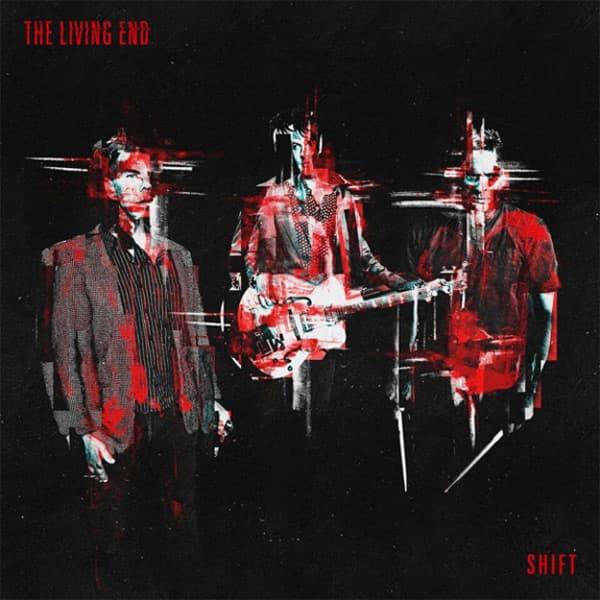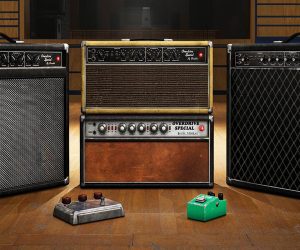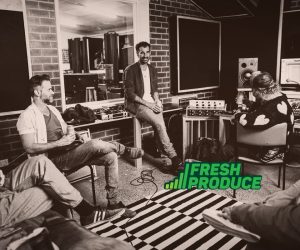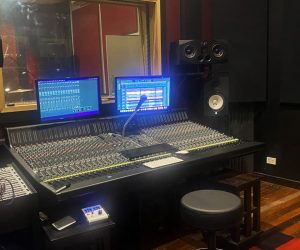
New Life For The Living End
The Living End are one of the tightest three-pieces around. But Shift was the first time the band has ever written songs together by jamming in the studio.

Artist: The Living End
Album: Shift
It’s been a while since The Longnecks have surfaced on a bill, or Glen Waverley & The Mentones, The Dovetones, Roller Toasters, and Doncaster & The Dandenongs for that matter.
All band names — pseudonyms actually — you’ve probably never heard of unless you’re a die-hard fan of The Living End. If one of them was written up on a chalkboard at the Barwon Club or Ding Dong Lounge, you knew the boys were up and about road-testing new material.
It’s always been the way the band has honed their tunes. Lead singer/guitarist, Chris Cheney, would write the songs; the band would rehearse them and add their own flavours to it; then they’d assume a fresh identity and refine the new songs in front of a pub audience.
However, five years have passed without a sighting. Cheney has been living in LA, and only The Living End proper had appeared on any bills. With time and distance growing the gap, if there was any chance of fresh Living End material, it seemed likely to start with Cheney. But he, like everyone else, was a little burnt out. “We did the retrospective tour where we played all of our records — seven nights in each city,” said Cheney about the breaking point. “It was an enormous undertaking to do a tour like that.” The band had gone their separate ways — the other guys picked up side projects and Cheney played in a couple of bands in The States while songwriting with other people.
At the end of 2014, they played a run of A Day on the Green shows in support of Jimmy Barnes. It was a relaxed, weekends-only winery tour. With time to kill, the band did something they’d never done before; they rocked up at Red Door Sounds and wrote songs together.
The idea, said Cheney, was “no unnecessary pressure, just lay some sounds down, come up with ideas, and see what happens.” Which is exactly what happened for four weeks.
Paul ‘Woody’ Annison — Red Door Sounds owner/engineer and The Living End’s FOH engineer — co-produced, recorded and mixed the new album Shift, beginning from those very early sessions. “The whole idea was to do the opposite of what they’d done before. It was already four years at the time and Chris was no closer to writing a Living End album,” said Woody. “They’re used to me because I grew up with them over the last 15 years. We’re mates, it was supposed to be fun.” Over that first month, the sessions were free flowing. Woody reckons they played through over 60 riffs on the first day and started narrowing them down. By the end of those initial sessions, Cheney, along with bassist Scott Owen and drummer Andy Strachan had crafted five songs. However, there was another reason the band chose Woody — he’s a straight talker. After five years away, the band needed someone to let them know when to push harder and when enough was enough. Being their live engineer, he could also stand-in for the pre-recording session run of shows.
“He knows how we sound live and how we wanted to capture that energy,” said Cheney. “Because he’s a friend we felt comfortable going in and tossing around some ideas. He’s quite brutal. We knew he’d be cracking the whip and wouldn’t let us overdo it, over-polish it and over think it. Parts of it were absolutely nightmarish! We butted heads on many occasions.”
Woody agreed on the nightmare: “It was supposed to be a three-week project… it took a f**king year! Chris is pedantic and I love him for it. We definitely had tense moments, in a light-hearted way. Everyone’s got an opinion but Chris and I shout the loudest.”
Cheney said that push and pull was exactly what they needed. If Cheney had a weird idea for a song, he needed to prove it to three blokes eager to move on. “That’s what we needed for this experiment,” reckoned Cheney. “Otherwise we’d go on to make a really beige-sounding record. It’s good, there’s a lot of variety on this album. There’s definitely some more polished, moulded tracks and there’s some that are just abrasive.”


We knew he’d be cracking the whip and wouldn’t let us overdo it, over-polish it and over think it. Parts of it were absolutely nightmarish!
REVOLVING RED DOOR
Red Door Sounds is housed in the remnants of a Melbourne music industry hub. Previous tenants of the Collingwood complex included the Big Day Out headquarters and Crucial Music management. Big Day Out no longer exists, and Crucial, The Living End’s management, moved out long ago. Woody bought the studio in 2010, then called Studio One, along with Crucial Music’s Rae Harvey (Woody’s then partner), as well as Chris and Emma Cheney.
These days it’s just Woody, and he’s feeling the struggle of being an owner/operator, especially because he’s on the road mixing FOH for The Living End and Peking Duk: “If I go on tour, the studio goes empty because everyone wants to make their own money and do their own thing. Just maintaining this gear is a pain in the arse.”
Looking around the studio, it’s a lot of gear to maintain. A stretched out SSL 4000 G+ console takes up the front of the control room, with a Neve 51 Series sidecar sitting off to the side. He bought the console from Scott Horscroft when BJB closed down, and has been selling off channel strips to pay for other gear. He uses the Neve as a recording front end, because the preamps and EQ are “sweet”, while he prefers the nasty bite of the EQ on the SSL to mix.
Woody also loves the SSL bus compressor and the back bus routing for parallel compression. “Everyone’s talking about parallel compression,” he said. “I’ve been doing it for years because I can on the console. I whack the drums through the Fatso then bring them up as a parallel group in the back bus. The more I put in there, the less they are in the front bus. It means I can smash the shit out of it but still have the transients come off the front. It’s classic parallel compression, but on the console, so it’s really intuitive.”
Woody’s racks are packed with quality outboard like Neve 1073 and Vintech X73i preamps, Teletronix LA-2A, Tube-tech CL1B, ELI Distressor and Fatso, and dbx 160 compressors, Tube-tech Pultec-style EQ, Lexicon effects and loads of other pieces.
He’s not all out of the box though. Woody often uses UAD and Brainworks plug-ins, sometimes preferring them. For instance, he has a hardware SPL Transient Designer, but regularly uses the plug-in version because he finds it more creative.
HOME SWEET HOME
Being back at Red Door was a homecoming of sorts for Cheney, who co-owned the studio for over a year. Studio ownership had been a trial for Cheney, a chance to have a stab at producing a couple of EPs. “It was good experience,” he said. “A different way of looking at the whole thing, from being in the band to being outside and having to look at every aspect.”
It helped Cheney uncover a more fastidious, experimental side of his songwriting. While some of the jammed ideas were good, a lot needed to be methodically fleshed out away from the studio.
When Woody bought Cheney out of Red Door, he set the singer up with a luxurious home studio; Vintech X73i preamp and EQ into a Distressor, with Pro Tools for a DAW. All of which did nothing for Cheney’s production values. “He just used some shitty sampled drums and DI’d straight into Garageband!” said an exasperated Woody.
For Cheney, it was part of the whole approach, to not get too caught up in spending days getting a sound right, but prioritising songwriting. “I’d take the songs back home, put them into Garageband and redo the lyrics, rewrite some of the chords and melodies and give them a complete facelift,” said Cheney. “I would just follow a tangent and end up somewhere completely different. It’s weird for the other guys because I’d bring the song back after a month-and-a-half away and it’d be completely different. Enemies was really loud and energetic, then we stripped everything back and went for this sound that had real tension in it.”
“We got that song recorded all the way up and thought it was really average,” recalled Woody. “I think we did that song three times before it became Andy playing a simple drumbeat… thud, chk, thud, chk.”
Cheney says moving to LA, wasn’t about escaping personal trials and tribulations, but the tension of his own unresolved struggles still found their way into the lyrics. “They’ve ended up working their way into the songs more so than before,” said Cheney. In the past he’s skirted around those issues, or sugarcoated them from a third-person perspective. This time, those writer’s tricks weren’t working. “Every time I sat down to write something, it ended up being very personal,” he said. “It’s all I could write. There’s nothing like cringing at a lyric to make you really feel it! I don’t mean cringing as in, ‘That’s awful!’ I mean a bit too close to home; so raw it hurts a bit.”

STUDIO SPACE CRAFT
There are three recording spaces at Red Door — one live, one dead, and another with adjustable baffling. For the sessions, Woody set up the drums in the live room, a collection of guitar amps in the dead room, and the bass amp in an iso booth. All of the tracks were built up from a live performance base, but some were completely re-recorded with overdubs. “They’re good enough players to play and replay,” said Woody. “We went back and redid drums on Monkey and a couple of songs where we came up with better ideas.”
Woody prefers the rawer tracks on the album, songs like the energetic vamped opener One Step where the performance has the least artifice. Even the ‘yeow’ and ‘ra-ra-ra’ ad-libs were samples from Chris “just being a dickhead” on the guide vocal take, which Woody chopped up to sound like The Rapture.
SPLIT DECISION GUITARS
Cheney is one of Australia’s iconic guitarists, his rockabilly influences are as identifiably unique as his Gretsch White Falcon hollowbody guitar. For some fans it’s almost sacrilege that he predominantly played a Telecaster on Shift. Like Owen’s upright bass, so ingrained is the hollow body in The Living End’s image, he’s still pictured holding it on the cover of Shift even though he played a Telecaster for most of the album. “I use a Telecaster to get out of my comfort zone of playing the big hollow-body Gretschs,” explained Cheney. “They add a certain attack and are so responsive that I could really dig in. That said, I would also double it with my White Falcon or one of my other Gretschs. I feel sort of lost without that in my hands.
“I played a Les Paul on a couple of tracks and a Danelectro which sounded like absolute crap but in the best possible way. It was so stringy and sharp, but it created a nice blend when mixed in with the other guitars.
“The pedals I used were mainly delays, a couple of Roland Space Echo tape delays, and we cranked up the reverb on this album, no fancy stuff.”
Sticking to convention wasn’t really an option on this record, nor was labouring over guitar sounds. “I’ve had to do a whole EP in three days before,” said Woody. “Whereas with The Living End, that’s just getting a guitar sound.”
For this record, it just wasn’t as important to Cheney as the lyric and the song. Even though the song’s were constantly rearranged, Cheney and Woody didn’t sit down and work out an amp to suit each part. Instead they split Cheney’s guitar signal with a Radial JD7 Injecter and blasted it like a shotgun spray out of multiple amps. “We had three or four amps running at the same time,” said Cheney. “My old ’60s Vox AC30, one of my 100W Wizard heads through an old Marshall cabinet, and an old ’60s Fender Bassman. It wasn’t a record where we really mixed and matched the guitar tones too much. It’s always been more about the way we play the song as opposed to relying on really different sounds between tracks.”
Woody miked each amp up with a simple Shure SM57 moved around until it sounded right: “Admittedly 57s don’t have the low and high end, but unless you’re Robert Fripp, why would you need more?” He sent each through a Neve preamp and compressed the signal a little with the Distressor. “The Distressor is on virtually everything,” said Woody. “I like that it can sound like different things, it’s just handy. Most of the time I won’t let it slam the attack, I’ll use the distortion modes to get tone.
“We miked the back of the amps on a couple of songs, though I don’t remember whether it made it. The trouble is in this control room you’ve got to make it bright. Chris is used to standing in front of his amp to get this really warm tone. But if it sounds like that coming out of these speakers, it’s going to be dull. It’s just about knowing the room and the reality of it.”
They would double track chorus guitars, sometimes recording up to six versions before paring it back to a left and right pair. “Basically blending it till it sounds right,” said Woody. “If you overdo it, it can get a bit like a Foo Fighters block chorus with no definition. All the notes and distortion flow into each other and it’s just a blanket. If a guitar’s feeling a bit light on, you’re better off gaining it up and adding some tubey harmonics.”

![image2[1]-pichi](https://www.audiotechnology.com/wp-content/uploads/2016/07/image21-pichi.jpg)
DOUBLING DOWN ON BASS
Cheney isn’t the only virtuoso, all three members can hold their own. Woody says each of Owen’s bass overdubs took no longer than 20 minutes. “He’s not an over-thinker, he trusts I’m going to get a good tone, his rig is good and his bass is nice,” said Woody. “He doesn’t care as long as he plays tight, and he plays tight.
“We ended up facing the double bass into the corner and used a Neumann U87 to capture the sub element on his bass, either a Sennheiser MD421 or EV RE20 type mic on the f-hole of his bass, then his pickup fed his amp in an iso booth.
His bass has got so much sub and a beautiful tone, But on a couple of songs we wanted to make it sound more like a standard bass, so I just used the DI. The real bass just sounded too big and lush.
“I used the Slate Dragon 1176 rip off, it’s like a plug-in with its mix control, you can ram it but still get the front end so it holds together in the mix. I miked the amp with a Rode Procaster, it’s like an RE20 but a bit cleaner.”
DRUMMING UP FRESH SOUNDS
The live room, where the drums were placed, makes up in height what it lacks in length. “Believe it or not, it’s a really good sounding room,” said Woody. “I used to use room mics but lately I’ve just been using EV RE20s on the floor and ramming them. I became a bit bored with a normal ‘good’ drum sound.
“Andy’s got a room the double the size of my live room just full of drums, including some nice vintage Rogers kits. We used an 18-inch floor tom he’d converted into a kick drum for some of the tracks. The smaller it was, the bigger it sounded. Every time I record a 24-inch it sounds terrible, but a nice small kick drum is tight and solid.”
Woody uses a Sennhesier MD421 for the kick drum, but noted it’s still about the drummer. Woody: “Kick drums are a pain in the arse, especially if it’s not set up right or they belt the shit out of it. I’ve tried to explain to people that the softer they hit the more solid it is. If you belt the shit out of the snare drum it’s going to be thin, especially if you rim it.”
Apart from the rammed floor-bound RE20s, Woody said “it’s a pretty standard setup, except for Royer ribbon mics as overheads, nothing too fancy pants. I went for a closer sound on the kick and snare so it felt cooler, as opposed to roomy snare drums. Staring Down the Barrel is supposed to be like Bruce Springsteen’s Dancing in the Dark, which is why the snare goes, ‘Ptt’. People get fooled into what they remember something sounded like. Zeppelin is another classic, ‘Wooaahh, the drums are massive!’ Well, no they’re not. If you actually listen to it, they’re quite back, but where he’s playing behind the beat makes them sound big. Dancing in the Dark has the worst drum machine sounds in history.”

MIXED APPROACH
Woody wasn’t supposed to mix the album, but the band wanted him to have a crack. Ironically, he started out on that unnatural ’80s drum sound from Staring Down the Barrel, and it got him the gig.
These days Woody does a board mix, then gets his assistant to spit out stems, which he takes home to polish off. He’s got the same Genelec monitors and a UAD Apollo at home, he also uses Pro Tools’ Heat console emulation plug-in. “Sometimes it’s good to get that perspective out of here,” he said. “It’s not like the old days where you’re done and then it’s pressed, anyone can change anything now. It used to be less stems too — just drums, bass, guitar, vocals — now it has to be kick, snare, kick and snare so the compressor sit them together, etc.”
Woody’s never been afraid of using plug-ins, especially ones that add a bit of harmonic saturation. He used to have an outboard Shadow Hills compressor, but sold it and bought the UAD version so he could have eight, rather than one instance. Woody: “It’s not going to sound like one of them, but it’s going to take the characteristics of it. I love the Vertigo Sound VSC-2 compressor too because it adds harmonics, I’ve been running it over mixes lately.”
KEEP ON RUNNING
Sometimes plug-ins just plain saved his arse. Keep On Running was the only song that Cheney had pre-written in LA. It was never intended to be a Living End song, but “once the band played it, the song sounded a million times better than the original,” said Woody. “I kept on calling it Lion King, because it had this tribal drum beat.”
Because it wasn’t on the radar for The Living End, Cheney had recorded the strings and his vocal in The States… all of it except for three words. Woody used Izotope’s Ozone EQ matching function to keep continuity in the new parts. “That saved my life so many times,” said Woody. “We’d record the vocal one month, then three months later we’d be recording a fix or change the words. Even when it’s the same mic, same EQ, it’s always different. The matching EQ was always a good place to start. Get it close, then go in and alter it with a bit more EQ.
“It’s hard work for something nobody will notice, but I don’t mind doing that. No matter how long I’ve been making records, the most important thing is still the performance. No matter how good or how shit I make it sound, if it’s got no vibe, there’s nothing you can do.”
There are moments on Shift, like Keep on Running that will stretch the palette of The Living End fans, but Cheney reckons the nightmarish side of more fully fleshing out the songs was worth it: “Through butting heads with Woody in the studio, we got a great result. No-one was just bowing down and going with it for the sake of keeping the peace. We were fighting for the best possible outcome.”
















Is a strange TLE album but after read this article is easier give more value to the album.
I love the way they have grown up as musicians.
My fav ones are “Death”,”Coma”, “Staring Down The Barrel”, but specially “With enemies like that”.
Only for that feeling in the night…the album is gold…THANX A LOT FOR THAT.